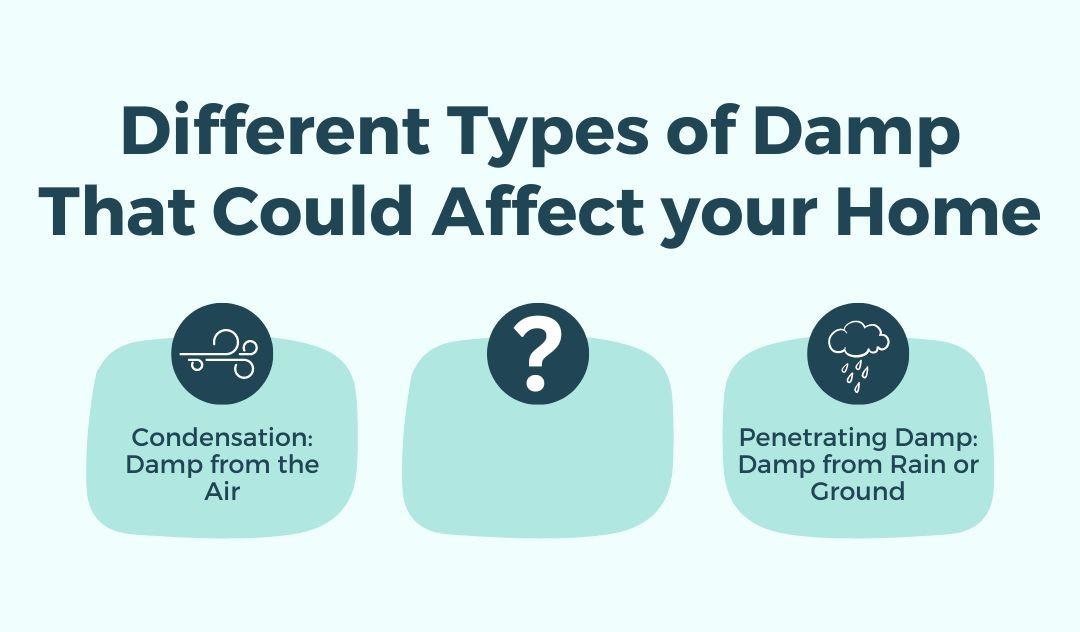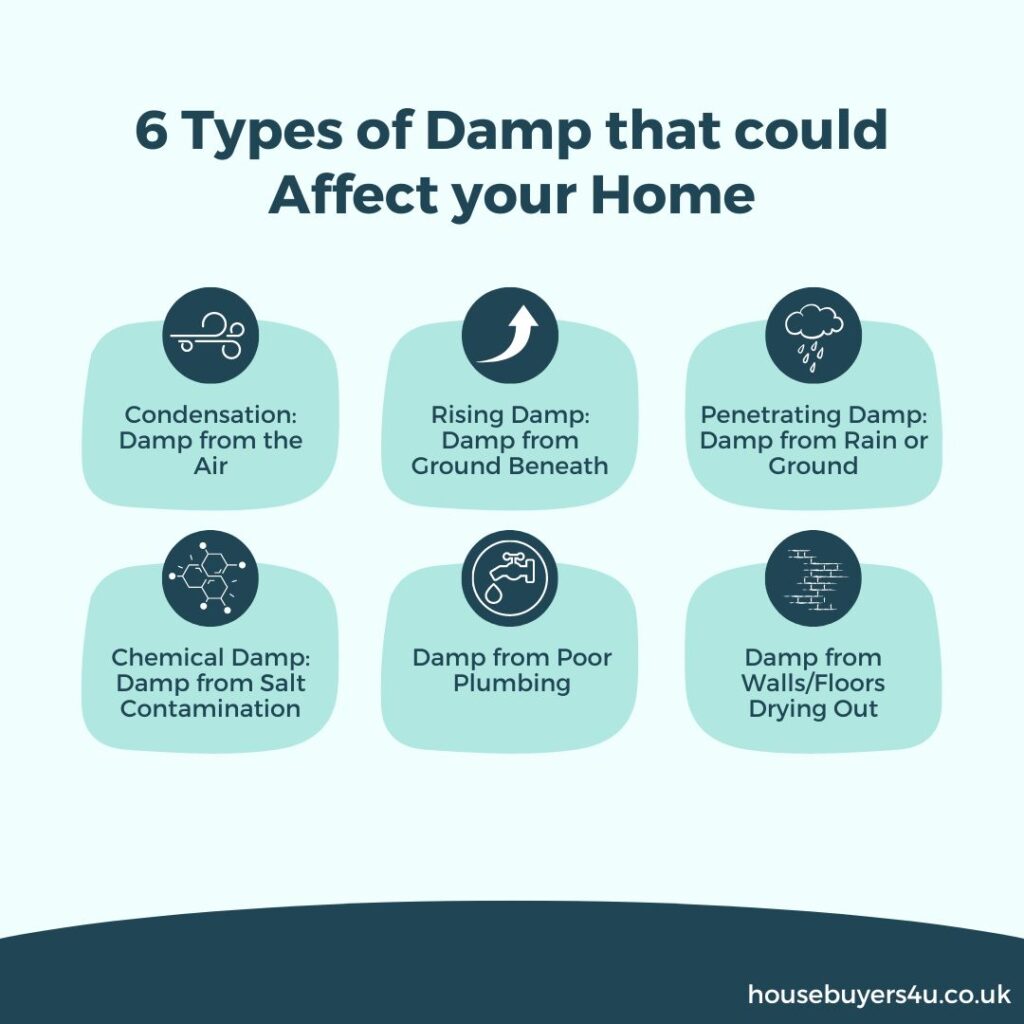What Type of Dampness do you Have? Identify, Fix & Prevent

Updated: August 2023
Did you know that unchecked “types of dampness” can reduce a property’s value by up to 20%?
Understanding dampness in homes is more than just a maintenance task; it’s a safeguard for your health and investment. In this guide, we’ll unravel the six key types of dampness every homeowner should know. Stay with us to protect your home and pocket.
Identifying the exact type of Dampness is critical
Correctly pinpointing the specific types of dampness in your home isn’t just about aesthetics; it’s a matter of safety and financial prudence. Misdiagnosing or overlooking damp can lead to escalating repair costs and financial difficulties down the line.
More alarmingly, certain types of damp can pose serious health risks, from respiratory issues to allergic reactions. Beyond health, the structural integrity of your home is at stake. Dampness can weaken foundations, damage plaster, and even corrode metal fixtures. In essence, understanding and addressing dampness is a proactive step in preserving both your well-being and your property’s value.
The 6 Different Types of Damp that could Affect your Home
1) Condensation – Damp from the Air
According to Somerset.gov, Condensation is one the of most common types of dampness encountered in homes.
It forms when warm, moist air comes into contact with cooler surfaces, like windows or walls, causing the moisture in the air to condense into water droplets. Everyday activities like cooking, showering, or even just breathing can release moisture into the air, leading to condensation if not properly ventilated.
Key Features to Identify Condensation Damp:
- Water droplets or misting on the inside of windows
- A musty smell, often accompanied by mold, particularly in corners of rooms or behind furniture.
- Peeling wallpaper or flaking paint on walls.
- Dark, damp spots on ceilings or walls.
Potential Solutions and Preventive Measures:
- Ventilation: Ensure rooms, especially kitchens and bathrooms, are well-ventilated. Using extractor fans or opening windows can help reduce moisture levels.
- Dehumidifiers: These devices can be used to reduce the moisture content in the air, especially in particularly damp areas.
- Insulation: Proper insulation can help keep the surfaces in your home at a consistent temperature, reducing the likelihood of condensation.
- Regular Maintenance: Check and clean seals around windows and doors to ensure they’re effectively keeping out moisture.
- Avoid Drying Clothes Indoors: If you must, ensure the room is well-ventilated
2) Rising damp – Damp from the Ground Directly Below your Home
Rising damp is a type of moisture that ascends from the ground and travels upwards through the walls by capillary action. It occurs when the damp-proof course (DPC) – a barrier installed to prevent moisture from rising – is either damaged, bridged, or absent. The moisture can carry soluble salts, which can further damage the interior surfaces of the property.
Key Features to Identify Rising Damp:
- A “tide mark” of yellow or brown staining, typically up to 1 meter above the floor level.
- Deterioration of skirting boards and floor timbers.
- Wallpaper peeling away from the base of the wall.
- A musty smell, indicating the presence of mold.
- Salt deposits on the wall surface, often appearing as white, powdery patches.
Potential Solutions and Preventive Measures:
- Damp-Proof Course (DPC) Installation or Repair: If the DPC is damaged or missing, it may need repair or replacement. This involves injecting a chemical DPC into the walls or laying a physical DPC during construction.
- Replastering: After addressing the root cause, walls affected by rising damp often need to be replastered using a salt-resistant mix to prevent future damage.
- Good External Maintenance: Ensure that the ground level outside your home is lower than the DPC to prevent it from being bridged. Regularly check and clear gutters and downpipes to prevent water buildup.
- Adequate Ventilation: Ensure sub-floor areas, especially those with timber floors, are well-ventilated to prevent moisture buildup.
Addressing rising damp promptly is essential. Left untreated, it can lead to significant structural damage and can be costly to rectify. Proper preventive measures and regular maintenance can help homeowners avoid the pitfalls associated with this type of dampness.
Related: How can Japanese Knotweed Affect my Property
3) Penetrating damp – Damp from the Rain or the Ground Against the Wall
Penetrating damp, as the name suggests, is moisture that penetrates through walls or roofs. Unlike rising damp, which moves vertically, penetrating damp can move horizontally through your property. It’s primarily caused by issues in the building’s structure, such as faulty roofing, cracked rendering, or damaged brickwork. Water from heavy rainfall or persistent leaks can find its way into these vulnerabilities, leading to penetrating damp.
Key Features to Identify Penetrating Damp:
- Localized damp patches on walls or ceilings that may darken when it rains.
- Dampness that gets worse after periods of heavy rainfall.
- Mold growth on colder external walls.
- Watermarks or tide lines that appear horizontally.
- A cold or chilly feeling in certain areas of the room.
Potential Solutions and Preventive Measures:
- Exterior Wall Repairs: Regularly inspect the external walls for cracks, damaged pointing, or defective masonry and repair them promptly.
- Roof Maintenance: Ensure that the roof tiles, flashings, and chimneys are in good condition. Replace any broken tiles and ensure the roof is adequately sealed.
- Guttering and Downpipes: Regularly clean and maintain gutters and downpipes to prevent blockages and overflows.
- Water-Repellent Treatments: Apply water-repellent treatments to external walls to prevent rain penetration.
- Improved Drainage: Ensure that the ground level around your property directs water away from the building, preventing it from pooling against walls.
4) Chemical Damp – Damp from Salt Contamination
Chemical damp, often referred to as salt contamination, arises when groundwater containing soluble salts penetrates the walls of a property. As the water evaporates, these salts crystallize within the wall’s pores, leading to a build-up that can attract more moisture from the surrounding environment. Over time, this cycle of moisture attraction and evaporation can cause significant damage to plaster and masonry.
Key Features to Identify Chemical Damp:
- White, powdery or crystalline deposits (efflorescence) on walls, especially at the base.
- Deterioration or crumbling of plaster and masonry.
- A persistent damp or musty smell, even in the absence of visible damp patches.
- Wallpaper or paint that appears blistered or bubbled.
Potential Solutions and Preventive Measures:
- Salt-Resistant Plaster: If walls are affected by salt contamination, they may need to be replastered using a salt-resistant mix to prevent future damage.
- Damp-Proof Membranes: Installing a damp-proof membrane can act as a barrier, preventing groundwater and its salts from penetrating walls.
- Ventilation: Ensure rooms are well-ventilated to aid in the evaporation of moisture, reducing the chances of salt crystallization.
- Regular Maintenance: Check the property’s exterior for signs of wear and tear, ensuring that there are no entry points for groundwater.
- Waterproofing: Applying waterproof treatments or sealants to external walls can help prevent the ingress of salt-laden water.
Chemical damp can be deceptive, as the damage often occurs beneath the surface. Early detection and intervention are crucial to prevent long-term structural damage and maintain a healthy living environment.
5) Damp from Poor Plumbing
Dampness resulting from poor plumbing is often a consequence of leaking pipes, faulty seals, or inadequate waterproofing in wet areas like bathrooms and kitchens. Even minor leaks, if undetected, can lead to significant moisture build-up over time, causing damage to walls, floors, and ceilings.
Key Features to Damp from Poor Plumbing
- Unexplained damp or wet patches on walls, floors, or ceilings, especially near plumbing fixtures.
- A consistent musty or moldy smell, particularly under sinks, near toilets, or around bathtubs and showers.
- Swelling, warping, or discolouration of wooden fixtures or cabinetry.
- Peeling paint or wallpaper in areas not typically exposed to water.
- Increased water bills, which might indicate a hidden leak.
Potential Solutions and Preventive Measures:
- Regular Plumbing Checks: Schedule periodic inspections of your plumbing system, especially in older homes or after any significant plumbing work.
- Address Leaks Promptly: Even minor leaks can lead to significant damp issues over time. Repair any leaks as soon as they’re detected.
- Waterproofing: Ensure areas prone to water exposure, like bathrooms and kitchens, are adequately waterproofed. This includes proper sealing around bathtubs, showers, and sinks.
- Proper Ventilation: Ensure rooms with plumbing fixtures, especially bathrooms and kitchens, are well-ventilated to prevent moisture build-up.
- Insulate Pipes: In colder climates, insulating pipes can prevent them from freezing and bursting, a common cause of water damage.
6) Damp from Walls/Floors Drying Out
Dampness from walls or floors drying out typically occurs in newly constructed or recently renovated properties. As new building materials, such as concrete, plaster, and timber, dry out, they release moisture into the surrounding environment. This is a natural part of the settling process for new materials but can lead to temporary damp issues if not managed correctly.
Key Features to Identify Walls/Floors Drying Out
- Damp patches or a feeling of humidity in newly constructed or renovated areas.
- Condensation on windows or cold surfaces, especially in the morning.
- A musty smell in rooms with new plaster or flooring.
- Wallpaper or paint that takes longer than expected to dry or shows signs of bubbling.
- Wooden fixtures or flooring that expands, contracts, or becomes warped.
Potential Solutions and Preventive Measures:
- Adequate Ventilation: Ensure rooms with new construction materials are well-ventilated. Open windows and doors regularly to allow moisture to escape.
- Dehumidifiers: Use dehumidifiers in areas with significant moisture release to speed up the drying process and prevent condensation.
- Delay Decorating: Wait for walls and floors to fully dry out before painting or wallpapering. This can prevent issues like peeling paint or bubbled wallpaper.
- Use Drying Aids: In professional settings, consider using industrial fans or heaters to expedite the drying process.
- Regular Monitoring: Keep an eye on new materials as they dry out. If damp issues persist beyond the expected drying time, it might indicate other underlying issues.
- Insulate Pipes: In colder climates, insulating pipes can prevent them from freezing and bursting, a common cause of water damage.
The Effects of Dampness on Health and Home
Health Implications of Living in a Damp Environment:
- Respiratory Issues: Inhalation of mold spores can exacerbate asthma symptoms and trigger allergic reactions, leading to sneezing, coughing, and shortness of breath.
- Skin Irritations: Direct contact with mold or damp surfaces can cause skin rashes, itching, and other irritations.
- Eye Problems: Mold spores can irritate the eyes, causing redness, itching, and watering.
- Weakened Immune System: Prolonged exposure to damp environments can weaken the immune system, making individuals more susceptible to infections.
- Mental Health Effects: Living in damp conditions can also impact mental well-being, leading to feelings of stress, anxiety, and depression.
Structural Damages from Untreated Dampness:
- Weakened Foundations: Persistent dampness can erode the structural integrity of a building’s foundation, leading to cracks and instability.
- Damaged Plaster and Paint: Damp walls can cause plaster to crumble and paint to peel or bubble.
- Wood Rot: Dampness can cause wooden beams, floorboards, and fixtures to rot, compromising their strength and durability.
- Corrosion: Metal fixtures, like pipes and nails, can corrode when exposed to persistent moisture.
- Decreased Property Value: Untreated damp issues can significantly reduce a property’s market value, as potential buyers often view it as a sign of neglect.
Related: 7 Ways to Check if your Property has Structural Damage
Damp Proofing: Protecting Your Home
Introduction to Methods and Materials Used for Damp Proofing:
Damp proofing is the first line of defense against the invasive and damaging effects of moisture in homes. It involves a combination of techniques and materials designed to prevent water from entering or spreading within a building. Some of the most common methods and materials include:
- Damp-Proof Course (DPC): A barrier, usually made of slate, plastic, or bitumen, is placed at the base of walls to prevent rising damp.
- Damp-Proof Membrane (DPM): A sheet or coating, often made of polyethylene or liquid asphalt, is used to protect floors and walls from penetrating damp.
- Waterproof Renders and Plasters: Specialized plasters and renders that resist moisture penetration, ideal for walls prone to dampness.
- Cavity Wall Construction: Building walls with a gap or cavity can prevent moisture from traveling from the outer to the inner wall.
- Ventilation: Proper ventilation systems, like air bricks or extractor fans, help reduce condensation by allowing moist air to escape.
Benefits of Investing in Damp Proofing:
- Long-Term Cost Savings: While there’s an initial cost to damp proofing, it can save homeowners significant repair and health-related expenses in the long run.
- Enhanced Property Value: Homes with effective damp proofing are more appealing to potential buyers, ensuring a better resale value.
- Improved Health: By preventing mold growth and damp-related issues, damp proofing contributes to a healthier living environment.
- Structural Integrity: Damp proofing protects the structural elements of a home, ensuring its longevity and safety.
- Peace of Mind: Knowing that your home is protected from the damaging effects of dampness offers homeowners peace of mind.
In essence, damp proofing is not just a protective measure; it’s an investment in the health, safety, and value of your property. Taking proactive steps today can prevent costly and stressful issues down the line.
Final Thoughts & Key Takeaways
Dampness, in its various forms, poses a silent threat to both the structural integrity of our homes and our health. From the subtle menace of condensation to the more overt damages of rising damp, understanding the “types of dampness” is the first step in safeguarding your property and well-being.
Key Takeaways:
- Early Detection is Crucial: The sooner you identify and address damp issues, the less damage they can cause.
- Knowledge is Power: Recognizing the signs of different types of dampness allows for accurate treatment, saving time and money.
- Damp Proofing is an Investment: Protecting your home from dampness not only ensures its structural integrity but also enhances its market value.
- Health First: Beyond structural concerns, damp environments can have serious health implications. Prioritize your health by addressing dampness promptly.
In conclusion, while dampness might seem like a mere inconvenience, its effects can be far-reaching. Equip yourself with the knowledge, stay vigilant, and take timely action to ensure your home remains a safe and comfortable haven.
We hope our article will give you a little insight into spotting the different types of damp so you can get it sorted out quickly before it spreads and causes more problems for you later on.
If you don’t have the time or finances to fix issues caused by damp – we here at Housebuyers4u are a national house buying company and will buy any house in any condition, so if you’re looking to sell your house, do get in touch!
Click here to get your no-obligation cash offer now!




